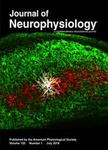版权所有:内蒙古大学图书馆 技术提供:维普资讯• 智图
内蒙古自治区呼和浩特市赛罕区大学西街235号 邮编: 010021

作者机构:Univ Washington Sch Med Dept Physiol & Biophys Seattle WA 98195 USA
出 版 物:《JOURNAL OF NEUROPHYSIOLOGY》 (神经生理学杂志)
年 卷 期:2000年第84卷第5期
页 面:2409-2416页
核心收录:
学科分类:0710[理学-生物学] 1001[医学-基础医学(可授医学、理学学位)] 07[理学] 071003[理学-生理学]
基 金:NHLBI NIH HHS [HL-49657] Funding Source: Medline NIGMS NIH HHS [T32 GM-07270, 5T32GM-07108] Funding Source: Medline
主 题:年龄因素 动物 新生 脑干/细胞学 脑干/生长和发育 脑干/生理学 中枢神经系统抑制药/药理学 导电性 乙醇/药理学 诱发电位/药物作用 诱发电位/生理学 甘氨酸/生理学 膜电位/药物作用 膜电位/生理学 神经抑制/药物作用 神经抑制/生理学 大鼠 Sprague-Dawley 反应时间/药物作用 反应时间/生理学 受体 甘氨酸/代谢 突触/药物作用 突触/代谢 动物 大鼠
摘 要:During postnatal motoneuron development, the glycine receptor (GlyR) alpha subunit changes from alpha2 (fetal) to alpha1 (adult). To study the effect this change has on ethanol potentiation of GlyR currents in hypoglossal motoneurons (HMs), we placed neurons into two groups: neonate [postnatal day 1 to 3 (P1-3)], primarily expressing a2, and juvenile (P9-13), primarily expressing alpha1. We found that glycinergic spontaneous miniature inhibitory postsynaptic currents (mIPSCs) in neonate HMs are less sensitive to ethanol than in juveniles. Thirty millimolar ethanol increased the amplitude of juvenile mIPSCs but did not significantly change neonatal mIPSCs. However, 100 mM ethanol increased the amplitudes of both neonate and juvenile mIPSCs. There was a significant difference between age groups in the average ethanol-induced increase in mIPSC amplitude for 10, 30, 50, and 100 mM ethanol. In both age groups ethanol increased the frequency of glycinergic mIPSCs, but there was no difference in the amount of frequency increase between age groups. Ethanol (100 mM) also potentiated evoked IPSCs (eIPSCs) in both neonate and juvenile HMs. As we observed for mIPSCs, 30 mM ethanol increased the amplitude of juvenile eIPSCs, but had no significant effect on eIPSCs in neonate HMs. Ethanol also potentiated currents induced by exogenously applied glycine in both neonate and juvenile HMs. These results suggest that ethanol directly modulates the GlyR. To investigate possible mechanisms for this, we analyzed the time course of mIPSCs and single-channel conductance of the GlyR in the presence and absence of ethanol. We found that ethanol did not significantly change the time course of mIPSCs. We also determined that ethanol did not significantly change the single-channel conductance of synaptic GlyRs, as estimated by nonstationary noise analysis of mIPSCs. We conclude that the adult form of the native GlyR is more sensitive to ethanol than the fetal form. Further, enhancement of GlyR